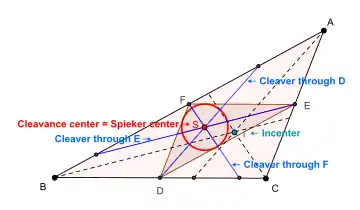Cleaver (geometry)
In geometry, a cleaver of a triangle is a line segment that bisects the perimeter of the triangle and has one endpoint at the midpoint of one of the three sides. They are not to be confused with splitters, which also bisect the perimeter, but with an endpoint on one of the triangle's vertices instead of its sides.

Construction
Each cleaver through the midpoint of one of the sides of a triangle is parallel to the angle bisectors at the opposite vertex of the triangle.[1][2]
The broken chord theorem of Archimedes provides another construction of the cleaver. Suppose the triangle to be bisected is △ABC, and that one endpoint of the cleaver is the midpoint of side AB. Form the circumcircle of △ABC and let M be the midpoint of the arc of the circumcircle from A to B through C. Then the other endpoint of the cleaver is the closest point of the triangle to M, and can be found by dropping a perpendicular from M to the longer of the two sides AC and BC.[1][2]
Related figures
The three cleavers concur at a point, the center of the Spieker circle.[1][2]
See also
References
- Honsberger, Ross (1995), "Chapter 1: Cleavers and Splitters", Episodes in Nineteenth and Twentieth Century Euclidean Geometry, New Mathematical Library, vol. 37, Washington, DC: Mathematical Association of America, pp. 1–14, ISBN 0-88385-639-5, MR 1316889
- Avishalom, Dov (1963), "The perimetric bisection of triangles", Mathematics Magazine, 36 (1): 60–62, JSTOR 2688140, MR 1571272